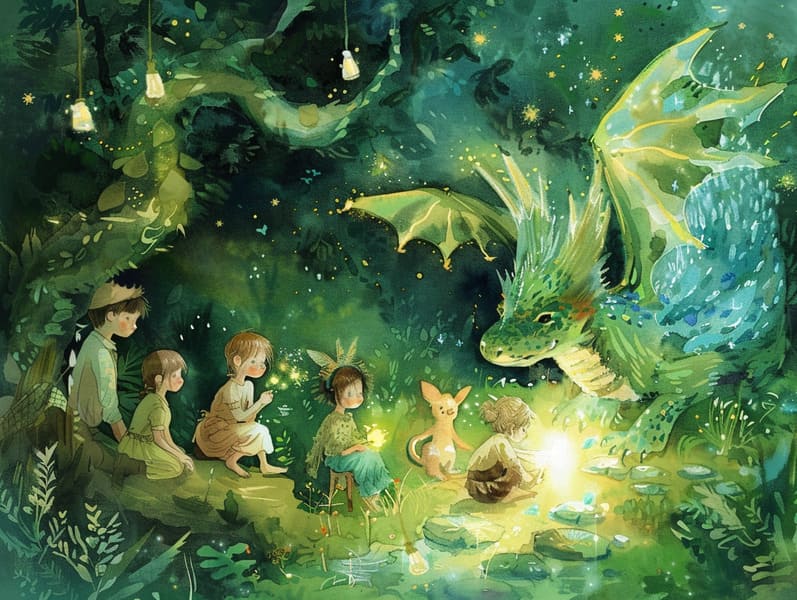
Timeless fairy tales have deep roots. These stories have been recounted from one generation to the next ages before they were ever recorded. They emerged from a variety of traditions, including African traditions. They were initially disseminated among elders, often carrying themes and messages related to the societal norms and beliefs of the time.
The famous Grimm duo, Jacob and Wilhelm, were among the first to gather many of these beloved stories. Their volume, "Grimm's Fables," included narratives like "Ashenputtel," "The Bread Crumb Trail," and "Schneewittchen," which have since become mainstays in the world of timeless fairy tales. Similarly, H. C. Andersen's whimsical narratives, such as "The Sea Maid," and "The Story of the Ugly Duckling," have captivated hearts worldwide, cementing their place in the pantheon of iconic fairy tales.
Despite being ancient, fairy tales remain as applicable as ever, especially as children's night stories. These fantastical tales are now available in different formats, including vividly illustrated books, magical animations, and online fairy tales.
Their unwavering allure can be traced to several captivating elements:
Vital Lessons: Ancient fairy tales often teach important moral lessons. Narratives like "The Tale of the Boy Who Cried Wolf" teach the virtue of being truthful, while "The Race of the Tortoise and the Hare" underline the virtues of steadfastness and humbleness. These tales offer young ones clear distinctions between good and bad, guiding their moral compass in a subtle yet significant way.
Kindness and Comprehension: Old fairy tales frequently showcase beings facing challenges and problems, prompting kids to comprehend with their struggles and cheer for their triumphs. For instance, "Beauty and the Beast" conveys the significance of valuing inner qualities to understand the real character of a individual, encouraging sympathy and insight.
Cultural Understanding: Many timeless fairy tales are steeped in the cultural contexts from which they originated. Delving into these fairy tales can provide fascinating glimpses into different social structures, strengthening a sense of world appreciation and acknowledgment.
Inventiveness and Imagination: The imaginative elements in classic fairy tales—mythical entities—enhance children’s imaginative ideas. These tales move readers to fantastical realms, stimulating innovative thinking and a sense of enchantment that endures a lifetime.
Old fairy tales are not only delightful but also informative. They provide bewitching tools in promoting various brain and heart skills in young ones. When classic fairy tales are spoken, they enhance verbal development by teaching new language and complicated sentence structures. This practice also nurtures auditory skills and attentiveness, as children concentrate deeply, expectant to see what happens next.
Furthermore, reflecting on the themes and characters of timeless fairy tales can strengthen thought processes and thought processes. Young ones are shown to notice patterns, anticipate outcomes, and comprehend cause and effect. These conversations also promote the young voice their thoughts and feelings, contributing to their emotional intelligence.
In today’s modern era, the availability of internet fairy tales has made these stories more available than ever. Websites and web apps feature ample collections of old fairy tales that can be accessed or listened via anytime, anywhere. Fairy tales told out loud are particularly liked, offering an captivating way for the young to relish these whimsical stories. Audio stories and voiced videos take characters and settings to life, often joined by mesmerizing audio effects and musical scores that intensify the storytelling experience.
The persistent attraction of classic fairy tales lies in their ability to modify to the present while keeping their central values. Contemporary reinterpretations of these tales often include more diverse figures and modern settings, making them understandable to today’s audience. However, the underlying themes of guts, benevolence, and equity remain unchanged, continuing to touch kids of all ages.
Old fairy tales also offer a sense of security and recognition. They disclose a coherent narrative with a straightforward beginning, middle, and end, often concluding with the conclusion of conflicts and the triumph of morality over wickedness. This foreseeability can be placating for the young, making available a sense of sturdiness in an ever-changing world.
Traditional fairy tales continue to mesmerize and train new generations, maintaining their loveliness and value in modern society. As bedtime stories for kids, they present to a perfect blend of delight and instruction, boosting moral values, empathy, and creativity. The availability of online storybooks and the prevalence of fairy tales voiced guarantee that these old stories remain within reach to new generations.
By perpetuating and telling these tales, we continue to cherish the rich tapestry of human imagination and cultural heritage. Whether you are browsing a gorgeously illustrated book, perusing a cyber collection, or listening through an audio story, the spell of classic fairy tales is always within short fairy tales for kids reach. These stories reveal of the persistent force of tales and its ability to hold us together across generations and cultures.
If you are delving into a artistically illustrated book, browsing a cyber collection, or listening on an audiobook, the delight of ancient fairy tales is always within reach.
These fairy tales demonstrate of the perpetual nature of storytelling and its ability to link us across generations and cultures, establishing a link that charms and informs alike.